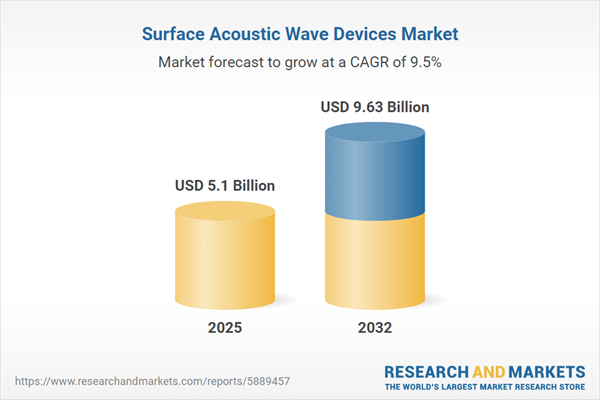Speak directly to the analyst to clarify any post sales queries you may have.
Surface acoustic wave devices are reshaping enterprise signal processing by equipping organizations to handle today’s evolving communications demands and technological shifts. This strategic overview addresses crucial trends and pragmatic pathways for senior decision-makers evaluating how to leverage these technologies for sustained operational advantage.
Market Snapshot: Surface Acoustic Wave Devices Market
The surface acoustic wave devices market is posting robust growth, propelled by sustained demand in telecommunications, aerospace, industrial automation, and consumer electronics. A surging pace in 5G network deployment and broadening adoption of IoT fundamentally reshape infrastructure, fueling the market’s momentum. Asia-Pacific dominates manufacturing with significant scale, enabling cost efficiency and high device availability. Meanwhile, North America and Europe distinguish themselves through ongoing innovation and leadership in advanced technology. Progress in material engineering and agile manufacturing advances versatility and reliability for users in all regional markets.
Scope & Segmentation of the Surface Acoustic Wave Devices Market
- Device Types: Delay lines deliver precise electronic timing; filters—covering band pass, high pass, and low pass—are critical for managing signal frequencies; resonators lend frequency consistency to diverse systems.
- Frequency Bands: Surface acoustic wave devices serve a span from sub-500MHz up to and exceeding 5GHz, empowering wireless infrastructure, manufacturing automation, and modern sensor applications.
- End Use Applications: These devices underpin essential operations in avionics, defense, radar, telecommunications, mobile and wearable tech, as well as complex controls in both industrial and consumer environments.
- Material Types: High-stability materials, such as lithium niobate, lithium tantalate, and quartz, deliver performance and temperature resilience, underpinning device stability in demanding scenarios.
- Geographic Regions: The Americas, EMEA, and Asia-Pacific all drive sector growth, with North America and Western Europe leading on technical progress and Asia-Pacific specializing in production scale and cost savings.
- Leading Companies: Firms including Murata Manufacturing, Qorvo, Broadcom, Skyworks Solutions, Taiyo Yuden, TDK Corporation, Samsung Electro-Mechanics, AVX Corporation, CTS Corporation, and Resonant Inc. spur market innovation with research and expansive distribution capabilities.
Key Takeaways for Senior Decision-Makers
- New materials enhance device working life and dependability, broadening their potential roles across evolving enterprise scenarios and enabling organizations to capture cost efficiencies over time.
- Manufacturing advances make compact device integration simpler, facilitating enterprise adoption of digital automation and streamlined process management.
- Standardized RF modules drive interoperability, equipping teams to deploy and maintain complex 5G and IoT networks with minimal compatibility disruptions.
- Flexible supply chain and manufacturing models help organizations adapt swiftly to regulatory, operational, or market changes, fortifying agility and compliance.
- Manufacturer and technology partner collaboration increases innovation velocity, expediting alignment with enterprise connectivity and infrastructure objectives.
- Growth in regional production capabilities supports organizations’ ability to navigate regulatory change and sustain operational continuity in shifting markets.
Tariff Impact and Supply Chain Adjustments
Shifts in US tariffs require surface acoustic wave device manufacturers to revisit sourcing and production strategies throughout their supply chain. Enterprises now focus on securing reliable sources for piezoelectric materials and extending operations to areas with reduced trade barriers. Building durable supplier partnerships and diversifying production geographies strengthens supply chain resilience and cushions against material cost volatility. More adaptive production and logistics workflows are essential for meeting delivery timelines and maintaining compliance in multi-jurisdictional markets.
Methodology & Data Sources
This analysis incorporates data from executive interviews, industry expert panels, shipment data reviews, and financial analysis. Scenario modeling and value chain assessments support reliable findings and inform senior leaders’ strategic planning.
Why This Report Matters
- Enables executives to direct resources to growth initiatives, partnership building, and investment in the dynamic surface acoustic wave devices market.
- Delivers clear frameworks for managing evolving regulatory landscapes and supply chains, so organizations can realign sourcing and production as needed.
- Guides product and market strategies in step with technology progress, positioning enterprises for enduring performance and competitive advantage.
Conclusion
Continued innovation in surface acoustic wave device technology and supply chain operations equips organizations for lasting progress. Senior leaders are empowered with essential insights to confidently navigate complexity and drive forward-looking strategies.
Additional Product Information:
- Purchase of this report includes 1 year online access with quarterly updates.
- This report can be updated on request. Please contact our Customer Experience team using the Ask a Question widget on our website.
Table of Contents
3. Executive Summary
4. Market Overview
7. Cumulative Impact of Artificial Intelligence 2025
Companies Mentioned
The companies profiled in this Surface Acoustic Wave Devices market report include:- Murata Manufacturing Co., Ltd.
- Qorvo, Inc.
- Broadcom Inc.
- Skyworks Solutions, Inc.
- Taiyo Yuden Co., Ltd.
- TDK Corporation
- Samsung Electro-Mechanics Co., Ltd.
- AVX Corporation
- CTS Corporation
- Resonant Inc.
Table Information
| Report Attribute | Details |
|---|---|
| No. of Pages | 180 |
| Published | October 2025 |
| Forecast Period | 2025 - 2032 |
| Estimated Market Value ( USD | $ 5.1 Billion |
| Forecasted Market Value ( USD | $ 9.63 Billion |
| Compound Annual Growth Rate | 9.5% |
| Regions Covered | Global |
| No. of Companies Mentioned | 11 |









